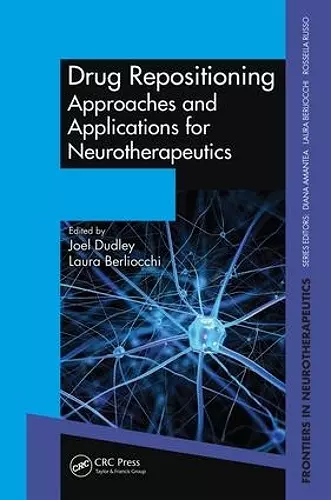Drug Repositioning
Approaches and Applications for Neurotherapeutics
Joel Dudley editor Laura Berliocchi editor
Format:Hardback
Publisher:Taylor & Francis Inc
Published:30th Jun '17
Currently unavailable, our supplier has not provided us a restock date
This hardback is available in another edition too:
- Paperback£74.99(9780367869076)

Nervous system diseases represent a major health concern worldwide. Although important financial and professional investment, their etiology and pathophysiology still remain mostly elusive. Moreover, the clinical need of disease-modifying therapies is still unmet.
In the last decades, traditional R&D has failed in identifying new effective therapies in many medical areas and drug repositioning has recently emerged as a promising alternative strategy to de novo drug discovery to improve and accelerate therapeutic development.
For the first time, Drug Repositioning: Approaches and Applications for Neurotherapeutics reviews history and advances in drug repositioning, with a special focus on therapeutics for nervous system diseases. International experts from Academia, Industry and Non-profit organisations will provide different views on drug repositioning advantages, challenges and specific applications, which will be covered for nervous system diseases including Alzheimer's, Parkinson's, Huntington's diseases, Amyotrophic Lateral Sclerosis, Spinal Muscular Atrophy, ischemic stroke, and psychiatric disorders.
This book provides a balanced overview and synthesis of drug repositioning concept, methods and applications for neurotherapeutics. It represents a valuable resource for students, scientists and clinicians working in academic settings, industry and government agencies within the fields of neuroscience, pharmacology, neurology, pharmaceutical sciences, drug discovery and development.
This excellent book is a must read for those interested in drug-repositioning and those involved in the hunt for new effective neurotherapeutics. The introductory sections of the book provide not only a clear explanation of the merits of repositioning but also an honest consideration of the difficulties of the approach. This is well illustrated by examples from the fields of Alzheimer’s and Parkinson’s describing successes and failures. Also introduced is the value of drug-repositioning to not-for profit organisations. Which adds to those who are involved in medical charity research to list of those who should read this publication. For the reader whose interest is piqued by the possibilities of drug repositioning and want to know more of the mechanics following chapters explore a variety of techniques that can be adopted for the identification of candidate repositioned therapies. Again, these an honest consideration with both pro and cons described. This makes the publication useful reading for any interested in repositioning irrespective of their field of interest.
The latter sections focus on repositioning for a very diverse range of CNS conditions. These include Parkinson’s, Alzheimer’s, Huntingdon’s, ALS, Spinal muscular atrophy and Ischaemic injury. For those with specific interests in any of the above this is a useful work. But in addition, I would recommend to those with a specific CNS disease interest reading the other chapters as they provide a potentially useful insight into methods and approaches than could be adopted within a specific interest.
Taken together this is valuable read and reference work for a diverse readership.
- Dr Alan Rothaul, Re-Pharm
Drug repositioning, also known as repurposing, seems an easy and straight forward route for the successful development of drugs. However, aspects of value creation and sound business cases are still essential, even if a drug has been fully or partly developed before.
Complexity is added to this situation by applying repurposing to the area of neurodegenerative diseases: pathogenesis of Parkinson’s, Alzheimer’s and other neurologic diseases of the higher ages are still poorly understood. Nevertheless, there is hope in repurposing even for this very difficult indication area, increasingly neglected by pharma companies due to extremely high development costs and numerous failures to successfully develop drugs.
Joel Dudley and Laura Berliocchi's book is disentangling the complexity and shows with many positive examples, that repurposing is possible, needs courage and attention to detail and sometimes also happens just by serendipity. Systematic approaches to drug repositioning, as well as funding mechanisms for repurposing projects and options to gain IP protection for existing drugs are comprehensively explained. Reading is highly recommended to newcomers in the field of therapy development for neurodegenerative indications as well as established scientists and medical doctors wishing to gain broad insight into the drug repositioning topic illustrated with plenty of case studies.
- Dr Bernadett Simon, PhD, RTTP, Head of Technology Transfer at DZNE, Bonn, Germany
ISBN: 9781482220834
Dimensions: unknown
Weight: 566g
313 pages